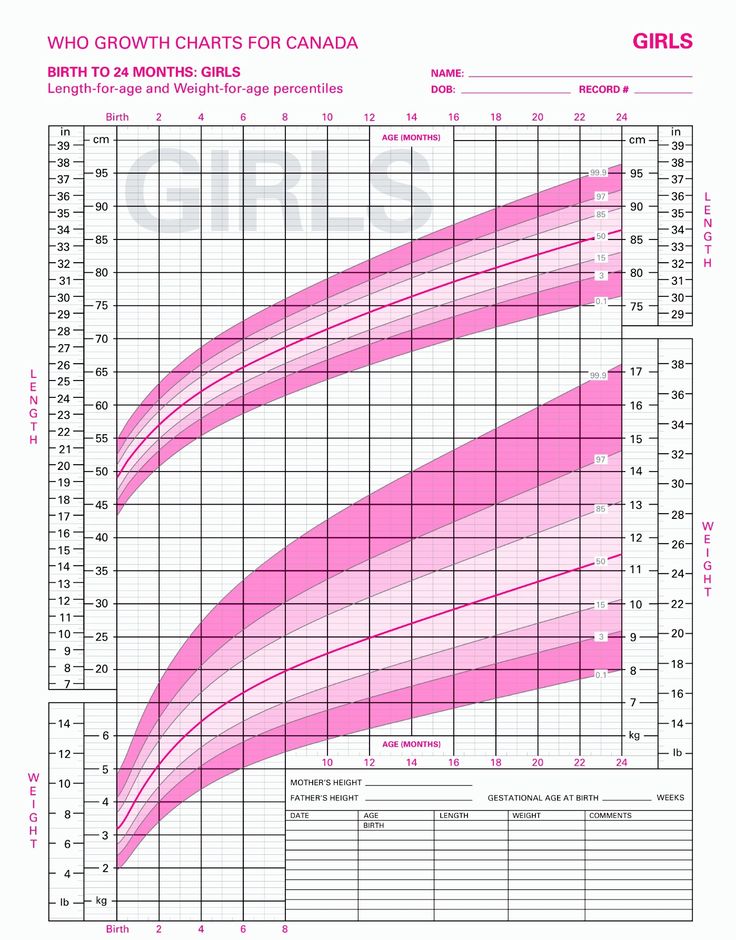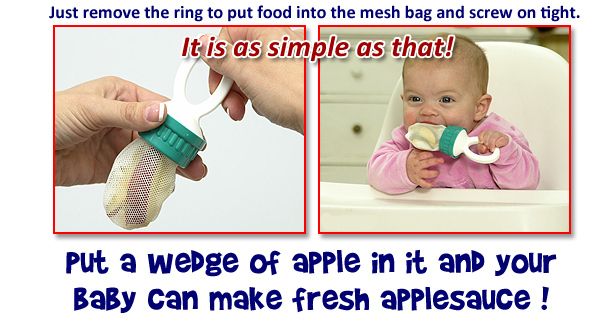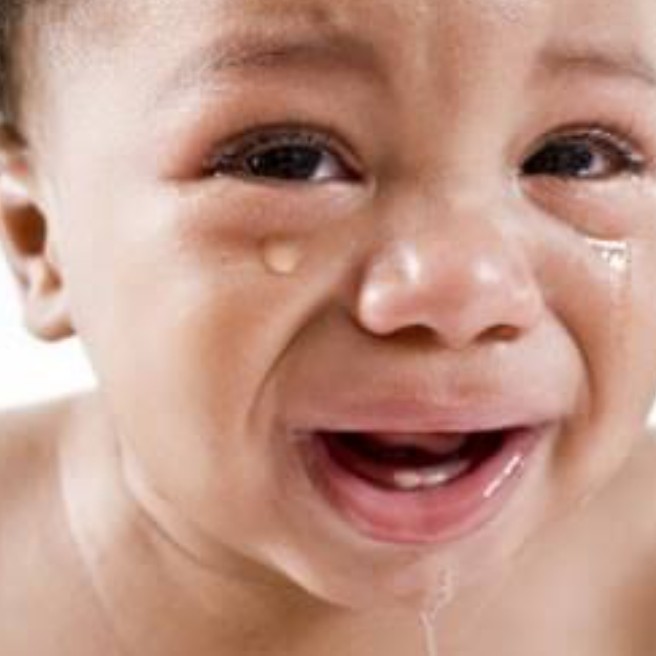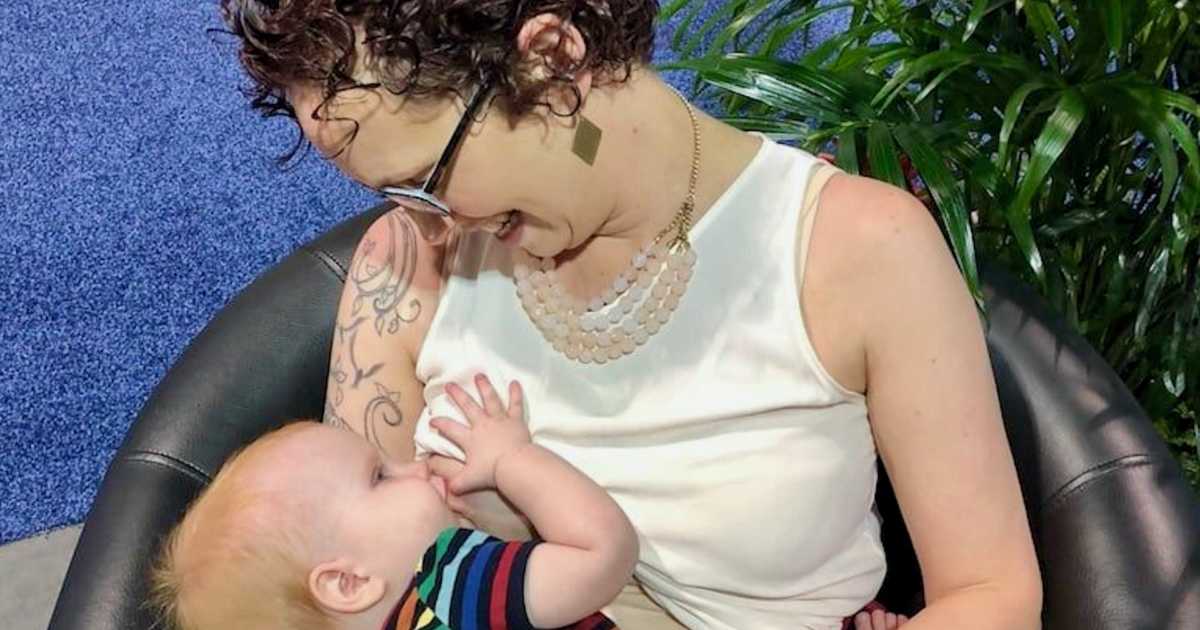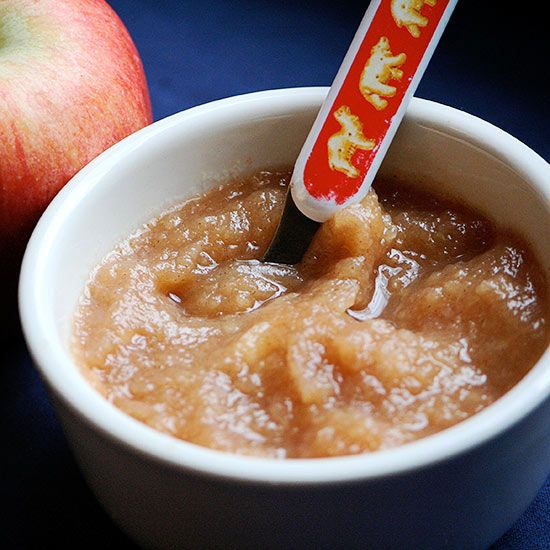Tube feeding baby pigeons
The Pigeoncote Emergency Pigeon Feeding
The Pigeoncote Emergency Pigeon Feeding
This is the size and shape of the syringe that works best for the very young. They can be found at drug stores and on-line.
Very young pigeons 2-5 days old
I have found that Kaytee Exact Baby Formula
used in a very liquid state is a substitute for pigeon milk. This is fed
through a syringe with a soft rubber or smooth metal bulbous tube attached to where the needle should
be. This is done by opening, gently, the baby's beak and carefully inserting
the tube all the way into the crop, making sure the tube goes over the top
of the tongue and against the back of the throat. Wet or lubricate the tube. Make
sure the tube is in the crop before pressing the plunger. Feed two or,
preferably, three times a day. There is no need to feed baby pigeons
during the night.
This larger size works best for young pigeons about five to three weeks of age. It is simpler if you get both sizes and be
ready to switch when needed.
From five to about 21 days old
At around 5 days old, start mixing the
Kaytee Exact according to the directions on the can, and it becomes more
of the consistency of a cheaper ketchup.. You also move up to a larger syringe
and tube. This will let you fill the squeaker up with one insertion,
great for you and the bird. The larger syringe lets the thicker mixture
flow through the tube. The tube is a very soft flexible rubber tubing. The thinner the tubing wall, the better, because it means a smaller
overall diameter with the largest possible interior diameter, permitting
the mixture to flow more readily. If there is too much resistance in
the tube, the mixture will not flow easily, and the tube may even shoot off
the syringe. Messy! Test to make sure you can easily press down
on the syringe before using it on the babe. No reason to squirt the
mixture all over it as well.
The thinner the tubing wall, the better, because it means a smaller
overall diameter with the largest possible interior diameter, permitting
the mixture to flow more readily. If there is too much resistance in
the tube, the mixture will not flow easily, and the tube may even shoot off
the syringe. Messy! Test to make sure you can easily press down
on the syringe before using it on the babe. No reason to squirt the
mixture all over it as well.
This larger size 60cc young birds over three weeks and also for adults. Again it is simpler to get all three sizes and be
ready to switch when needed.
From three weeks to adult
Once the baby is large enough to accept
a larger tube and syringe, move all the way to this 60 CC size in order to
accomplish the feeding with one insertion, not because they will take 60
CC of food!. I generally feed about 35-50 CCs at this stage, depending
on the size of the squeaker. At around three weeks, it is time to start
the weaning process by leaving a few small seeds for it to peck at and a
container of water so it can drink. If you have another pigeon(s) around
and you can arrange it, have the squeaker watch the others eat and drink
and eventually let it be with them. It will learn much more quickly
this way. Pigeons learn by imitation, just as we do. Once they
have started to eat and drink a little by themselves, try skipping their
morning feeding and see how they do. Drinking comes a bit slower, so
just dip the beak in the water a few times a day until they find that too.
You may have to give them water for more days than you did feed so keep watch
that they don't get too thirsty.
I generally feed about 35-50 CCs at this stage, depending
on the size of the squeaker. At around three weeks, it is time to start
the weaning process by leaving a few small seeds for it to peck at and a
container of water so it can drink. If you have another pigeon(s) around
and you can arrange it, have the squeaker watch the others eat and drink
and eventually let it be with them. It will learn much more quickly
this way. Pigeons learn by imitation, just as we do. Once they
have started to eat and drink a little by themselves, try skipping their
morning feeding and see how they do. Drinking comes a bit slower, so
just dip the beak in the water a few times a day until they find that too.
You may have to give them water for more days than you did feed so keep watch
that they don't get too thirsty. At first they will need supplemental
feeding in the afternoon and in the evening before you retire. Soon
you will be able to drop the afternoon and eventually the evening supplemental
feeding as well.
At first they will need supplemental
feeding in the afternoon and in the evening before you retire. Soon
you will be able to drop the afternoon and eventually the evening supplemental
feeding as well.
From about three weeks to independence
Ok, sounds easy, but how exactly do I do it?
Hand feeding works best with two people.
One person holds the bird and the other inserts the tube and presses
the plunger. Here's how we do it. One person holds the pigeon
in their right hand, placing the bird on a counter or other flat surface,
and cupping the right hand over the bird's back to hold it down firmly.
While holding the bird, place the thumb of the right hand behind the
bird's head. This will help to hold the head up and keep the neck straight,
making it easier for the other person to insert the tube. With the
left hand, grasp the lower half of the bird's beak. This will help
open the beak. The other person grasps the top half of the bird's beak,
opens the beak, and inserts the tube, being careful to insert it gently and
to place it over the tongue into the throat, keeping it against the back
of the throat, and gently easing it down into the crop (see diagram below).
If you feel any resistance, remove it and try again. For a good sized
squeaker, the tube will go in farther than you think it will. Remember, if
you're using a soft rubber tube, you can't hurt him with it. When you've
got it in, push the syringe plunger. If everything went perfectly,
the crop will instantly fill, and you can withdraw the tube with no muss
and no fuss.
With the
left hand, grasp the lower half of the bird's beak. This will help
open the beak. The other person grasps the top half of the bird's beak,
opens the beak, and inserts the tube, being careful to insert it gently and
to place it over the tongue into the throat, keeping it against the back
of the throat, and gently easing it down into the crop (see diagram below).
If you feel any resistance, remove it and try again. For a good sized
squeaker, the tube will go in farther than you think it will. Remember, if
you're using a soft rubber tube, you can't hurt him with it. When you've
got it in, push the syringe plunger. If everything went perfectly,
the crop will instantly fill, and you can withdraw the tube with no muss
and no fuss.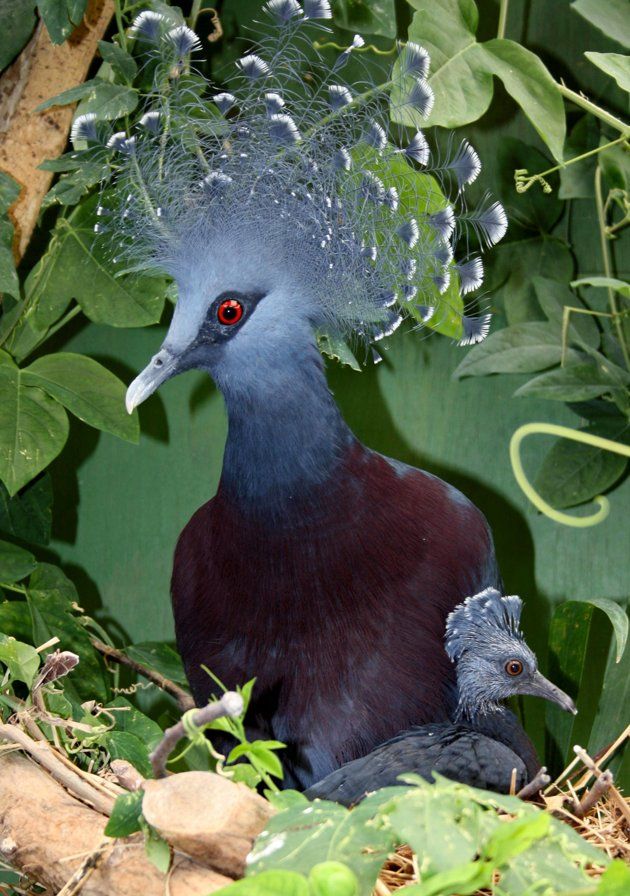 You actually get quite quick at this after doing it a
few times. We've found that the person using the syringe sometimes
has to lay the syringe on the counter, insert the tube, then pick up the
syringe and press the plunger. It's too hard sometimes to do it all
with the syringe in your hand--so have a long enough piece of tubing to allow
you to do this.
You actually get quite quick at this after doing it a
few times. We've found that the person using the syringe sometimes
has to lay the syringe on the counter, insert the tube, then pick up the
syringe and press the plunger. It's too hard sometimes to do it all
with the syringe in your hand--so have a long enough piece of tubing to allow
you to do this.
Notes: Very young babies that don't get real pigeon milk usually grow much more slowly than babies that get the milk so don't get discouraged and be patient. Hand feeding babies from day one is a last resort because they do grow much more slowly than when fed by their own parents, and sometimes they just don't make it.
Sometimes food will start coming out of the baby's mouth as you're pressing the plunger. This probably
means the tubing is not in far enough. Take it back out, let everybody calm down, and try again, inserting the tube
farther this time. If you have trouble inserting the tube, make sure you are keeping the bird's head up and its neck
as straight as possible.
This probably
means the tubing is not in far enough. Take it back out, let everybody calm down, and try again, inserting the tube
farther this time. If you have trouble inserting the tube, make sure you are keeping the bird's head up and its neck
as straight as possible.
Be gentle, stay calm, and remember that if you're having to hand feed the bird, it really needs your help and will die without it. We were very clumsy and nervous the first time we had to do this, but we've hand fed several squeakers and also some sick or injured adult pigeons, and we haven't killed one yet.
Babies need water, too. Keep a close watch on the babies when you first set them out to to see that
they get the water they need. Some signs to watch for are: blinking eyes or the crop will feel hard. If the crop is hard,
give them a little water with the syringe and tube, and massage the feed in the crop and it will soften up. Once you
see them take a good drink on their own, they will not have any more problems. But make it easy on them. Always place the water in the same container and put the container in
the same location in the cage. Just like people, pigeons need more water when it's hot, so watch them
closely in hot weather.
But make it easy on them. Always place the water in the same container and put the container in
the same location in the cage. Just like people, pigeons need more water when it's hot, so watch them
closely in hot weather.
Dr. Kevin Zollars, DVM:Even though fanciers have heard about it, or seen it
done, relatively few practice its use. Tube feeding by definition is the
passage of a tube from the mouth into the crop of the pigeon. The tube is
then used to pass liquid into the crop by means of a syringe. The fluid passed
into the crop can be water, electrolytes, vitamins, protein, fats, carbohydrates,
or a mixture of the above. Tube feeding can even be used for antibiotic
administration. Over the years, research has documented the usefulness of tube feeding. One piece of research was called Evaluation of water deprivation and fluid therapy in the Pigeon, written by Martin and Kollias. It was published in The Journal of Zoo and Wildlife Medicine. This research showed that in the face of 48 hours of water deprivation, tube feeding could be useful. It showed that the administration of a sugar solution (5% dextrose) into the crop by tube feeding was a very effective method for rapidly restoring fluid deficits. This was found to be even more effective than injecting the same solution under the skin of the pigeon. Tube feeding is like force feeding. Sick pigeons generally do not eat or drink
as much as they should. This is a natural phenomenon in all animals, including
man. Tube feeding can be beneficial in this situation. It will deliver vital
nutrients that the bird would otherwise not take in on its own. Again, there
are commercially made products for birds that contain all the necessary fats,
proteins, and carbohydrates that a sick pigeon needs. The first thing needed is a feeding syringe. Feeding
syringes are a little different than regular syringes in that they have a
larger opening at the end. This allows the passage of thicker and larger
materials, such as ground pellets or very thick feeding solutions. This is safer, because it will move with the
pigeon if it struggles, preventing damage to the mouth, esophagus, or crop.
The rounded tip provides easy passage of the tube into the crop. Rigid feeding
tubes such as the stainless steel ones can cause damage, if handled improperly. |
 Attempting to hold the bird upside down or trying to swab out
its throat will only cause undue stress. This will only increase the chance
of aspiration (the breathing in of some of the solution.) This can cause
infection but this is rare.
Attempting to hold the bird upside down or trying to swab out
its throat will only cause undue stress. This will only increase the chance
of aspiration (the breathing in of some of the solution.) This can cause
infection but this is rare.
Always lubricate the feeding tube before use. A small amount of a lubricant such as K-Y Jelly or Vaseline wiped on the tube will help its passage into the esophagus.
Feed liquids should be warmed slightly. Excessively hot or cold liquids can cause irritation and possible regurgitation.
Feeding formulas should only be stored in the refrigerator for a maximum of two days. There is a possibility of spoilage if stored for longer periods of time.
The cleaning of the feeding tube and syringe is important. This is especially
important when feeding a sick bird. The feeding can be from 70-100 kCal per day depending on the
health status of the bird. You would want to feed a total of 100 kCal to a sick non-eating pigeon
This is especially
important when feeding a sick bird. The feeding can be from 70-100 kCal per day depending on the
health status of the bird. You would want to feed a total of 100 kCal to a sick non-eating pigeon
Regular feeding formulas will contain 1.0-2.0 kCal per ml. Calorically dense formulas contain close to 2.0 kCal per ml
Wikipedia Commmons
How & When to Feed a Pigeon (or Dove) Who Isn't Eating -
Guest Post by Ashley Dietrich
Most pigeons and doves, when rescued, are dehydrated and starved (and often injured). Many will immediately drink and eat given the opportunity. If they don’t, that is a serious signal that expert help is needed. PLEASE connect with a pigeon-friendly rehabber or rescuer to help the bird you’ve found. It can mean the difference between their life and death. It is important to note that cases of severe starvation and emaciation must be handled expertly – with rehydration being of utmost importance. Too much food too fast or the wrong food can be deadly. These cases need expert care and possibly liquid formula feeding. Please join and post to our Palomacy Help Group for 24/7 assistance. You can also find pigeon-friendly rehabbers on our rescue map, at Find a Wildlife Rehabilatator (always ask about their pigeon policy as some will only euthanize rather than help) and search for an avian vet. (Also see Palomacy’s guidelines for How to Care for a Rescued Pigeon)
It can mean the difference between their life and death. It is important to note that cases of severe starvation and emaciation must be handled expertly – with rehydration being of utmost importance. Too much food too fast or the wrong food can be deadly. These cases need expert care and possibly liquid formula feeding. Please join and post to our Palomacy Help Group for 24/7 assistance. You can also find pigeon-friendly rehabbers on our rescue map, at Find a Wildlife Rehabilatator (always ask about their pigeon policy as some will only euthanize rather than help) and search for an avian vet. (Also see Palomacy’s guidelines for How to Care for a Rescued Pigeon)
Click here
It is important to know when and what NOT to feed. Birds should never be offered milk (they are not mammals), and for the most part should not have things like bread, oatmeal, and other low nutrient foods. Feeding the wrong thing can worsen a situation and even kill the animal by disturbing the digestive system – especially an animal already in distress. Never attempt to syringe feed or tube feed a bird without direct guidance from an experienced expert. Never pour liquid into the beak or force water. It is easy to aspirate a bird doing any of those things. Never feed a dehydrated or cold bird. Protocol is to first make sure they are warm, then hydrated, then address food intake. The best advice is always to get expert help, preferably someone local who can personally examine the bird and assess the situation before acting. If any pigeon (especially an adult) is not self-feeding, it is imperative to first determine the cause. A bird may refuse food for many reasons: immaturity, pain, stress, illness, disability, weakness, etc.
Never attempt to syringe feed or tube feed a bird without direct guidance from an experienced expert. Never pour liquid into the beak or force water. It is easy to aspirate a bird doing any of those things. Never feed a dehydrated or cold bird. Protocol is to first make sure they are warm, then hydrated, then address food intake. The best advice is always to get expert help, preferably someone local who can personally examine the bird and assess the situation before acting. If any pigeon (especially an adult) is not self-feeding, it is imperative to first determine the cause. A bird may refuse food for many reasons: immaturity, pain, stress, illness, disability, weakness, etc.
Supportive Care
Newly rescued pigeons or doves or our own pets sometimes need supportive care to help them through a crisis. A pigeon or dove that isn’t eating needs to be safely confined (protected from predators as well as flockmates that may bully or injure a weak bird), kept warm and quiet and encouraged or assisted to drink and eat.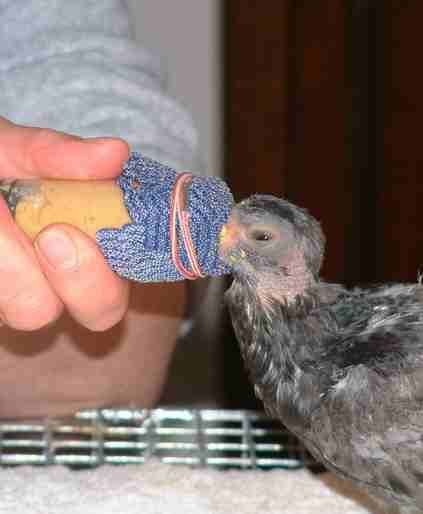 If you are helping a bird in this state, please engage an expert for one-on-one guidance. The following information is no replacement for expert help.
If you are helping a bird in this state, please engage an expert for one-on-one guidance. The following information is no replacement for expert help.
Hydration
Dehydration is extremely common in rescued birds. Some will immediately drink when water is provided. If a pigeon appears especially weak/tired, dissolve a small pinch of salt and a small pinch of sugar in the water you provide to help restore electrolytes. For an adult or juvenile pigeon who is not drinking, a safe way to encourage them is to dip the tip of their beak into a water dish and hold the water there for 20-30 seconds.
Pigeon Alfred leaning in to drink
The pigeon may immediately drink. If they do, you’ll know because they will plunge their beak forward and suck up water. Or the pigeon may not move at all or may move their head away. If they don’t drink or move their head away, try a couple of more times. Often we are able, after a couple of attempts, to encourage the bird to drink. Sometimes just the sound of running water along with the offered dish will help.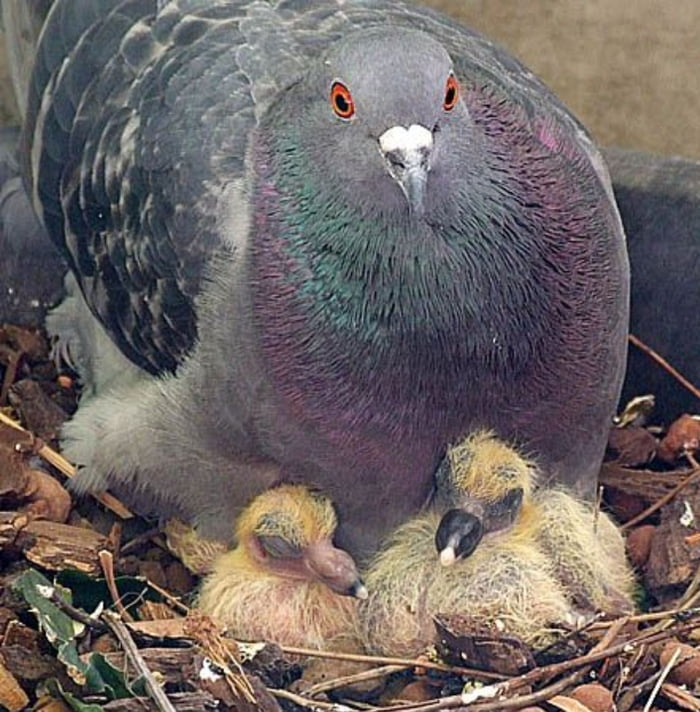 (Pigeons totally understand the sound of water.) Be gentle and patient, and do not force down the head or submerge more of the beak. For juveniles learning to drink, you can first try dipping your finger in the water to encourage them to dip their own beak. It will take multiple tries for them to master the skill. If the pigeon is not drinking- neither on their own nor with your help, you may need emergency avian vet care to save the pigeon.
(Pigeons totally understand the sound of water.) Be gentle and patient, and do not force down the head or submerge more of the beak. For juveniles learning to drink, you can first try dipping your finger in the water to encourage them to dip their own beak. It will take multiple tries for them to master the skill. If the pigeon is not drinking- neither on their own nor with your help, you may need emergency avian vet care to save the pigeon.
Myth-buster: Despite what is posted & often reposted on the web, pigeons do not need water 1″ deep to drink. They can suck up water from a nearly flat puddle if need be.
The Myth of Grit
One of the first questions people always ask when they find a bird is, What about grit? Pigeons and doves don’t actually need grit to digest their food. (That is a myth.) We actually see a lot more problems from birds overeating grit (which is salty and yummy) and becoming impacted than we ever have from a lack of grit. The only benefit of grit (or crushed oyster shells) comes in the form of minerals and calcium which birds definitely need long-term (also available through avian vitamin and mineral supplements like Nekkton’s and LeFeber’s).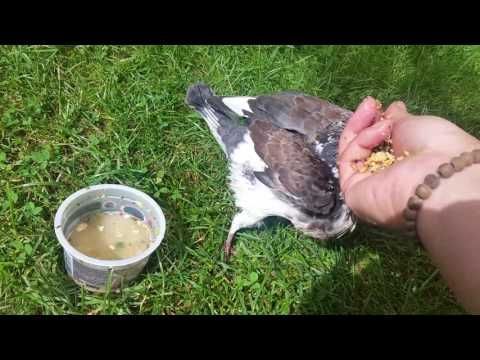
Feeding
For a found pigeon or dove, offer parakeet or wild bird type food (sold in supermarkets and pet supply stores if you do not have quick access to a pigeon/dove mix, sold in feed stores rather than pet stores) in a shallow, heavy flat-bottom dish (or the next closest thing). Offer water in a straight sided and/or heavy dish – ramekins work great.
Grains that pigeons & doves eat
Pigeons and doves are granivores meaning they primarily eat grains and seeds but they can also eat chopped vegetables and fruits. If you don’t have access to bird food, you can short-term feed a rescued pigeon or dove minced carrots, broccoli, cauliflower, edamame, lima beans, bell peppers, corn, unsalted chopped nuts, uncooked popcorn kernels, unsalted sunflower seeds (shelled or not), rice, quinoa or lentils (cooked or raw).
Ringneck dove Pierre eating chopped bell peppers
If it is determined that a bird, once warm and hydrated, is unable to self-feed and needs to be hand fed, a safe way to supplement food to restart their digestive system is to gently hand-feed frozen peas (not canned) that have been thawed in warm water. (Never microwave anything you are going to give a bird as the risk of accidentally burning them is very high.) Wrap the bird in a towel, not too tight, gently open the beak, and put in a pea. They will automatically swallow it down very safely. (There is no choking hazard like there is with syringe or tube-feeding.) Start slow, with only about 5-6 peas at first. Wait an hour or so to see that they poop. If they do, it means that the food is moving through their system and it is safe to give another 5-6 peas. If they don’t, offer more water but don’t hand-feed any more. This can be stressful to the bird, and it is better to hand-feed only small amounts every few hours until, ideally, the pigeon begins self-feeding or you get them to an expert. (Learn more about long-term feeding and caring for pigeons here.)
(Never microwave anything you are going to give a bird as the risk of accidentally burning them is very high.) Wrap the bird in a towel, not too tight, gently open the beak, and put in a pea. They will automatically swallow it down very safely. (There is no choking hazard like there is with syringe or tube-feeding.) Start slow, with only about 5-6 peas at first. Wait an hour or so to see that they poop. If they do, it means that the food is moving through their system and it is safe to give another 5-6 peas. If they don’t, offer more water but don’t hand-feed any more. This can be stressful to the bird, and it is better to hand-feed only small amounts every few hours until, ideally, the pigeon begins self-feeding or you get them to an expert. (Learn more about long-term feeding and caring for pigeons here.)
Juvenile Birds
People are often suprised to learn that a pigeon they rescued is still an immature juvenile, just learning to self-feed, because they can be as big as full grown birds and look adult to an untrained eye.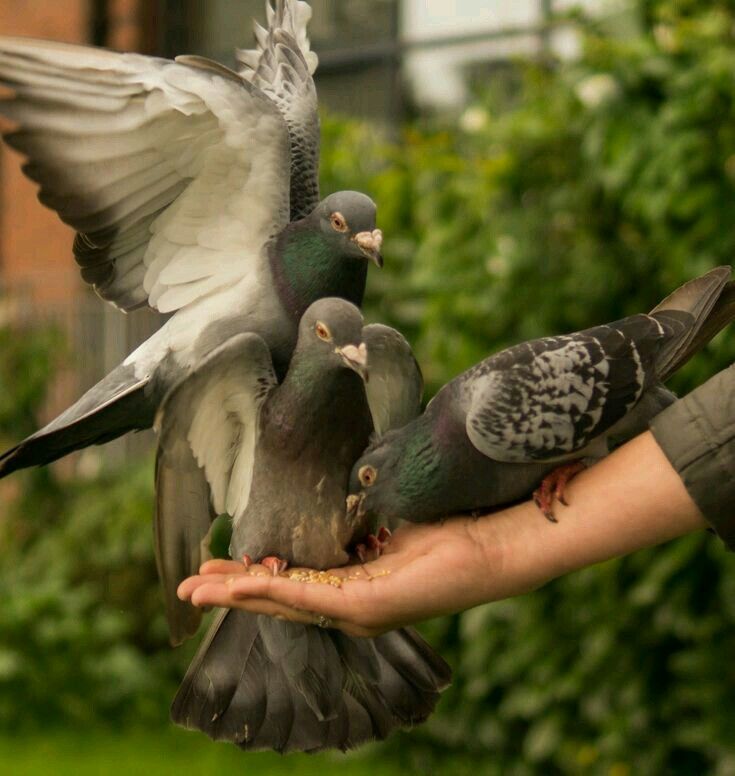 If the pigeon squeaks, it is for sure a juvenile. (Pigeons youngsters are called “squeakers” and stop squeaking around 6-8 weeks old.) If the pigeon has little gold threads amongst their feathers – juvenile. If they flutter their wings and thrust their beak at you or your hand- juvenile. They are used to being fed and need help to learn to self-feed. If you have rescued a nestling (not yet feathered) they will need to be fed in a way that mimics how their parents feed them. Please visit this website www.PigeonRescue.co.uk for lots of detailed, trustworthy info.
If the pigeon squeaks, it is for sure a juvenile. (Pigeons youngsters are called “squeakers” and stop squeaking around 6-8 weeks old.) If the pigeon has little gold threads amongst their feathers – juvenile. If they flutter their wings and thrust their beak at you or your hand- juvenile. They are used to being fed and need help to learn to self-feed. If you have rescued a nestling (not yet feathered) they will need to be fed in a way that mimics how their parents feed them. Please visit this website www.PigeonRescue.co.uk for lots of detailed, trustworthy info.
For a healthy juvenile learning to self-feed, peas can be used as a supplement, as an alternative to formula (for someone with no access to an expert to tube feed). Again, each case warrants specific consideration. To encourage a youngster to eat, scatter seed on a towel, and offer a seed dish as well, tapping your finger to mimic beaking food. If possible, put the bird in view of other birds eating, so he can learn by example. (Playing the videos above for a pigeon youngster while tapping your finger in bird seed will often help them learn!) Patience is key – they need support and encouragement as they learn to self-feed. Supplemental feeding may be needed until they are able to eat enough on their own. And please, don’t keep and raise up a feral (wild) pigeon youngster in your home. Get them to a pigeon-friendly wildlife rehabber so they can grow up to live wild and free. (The pigeon youngsters shown in these videos are unreleasable.) If you raise a feral pigeon youngster in your home, they will become imprinted on humans, they will be unreleaseable and they will need YOU to provide a wonderful home for 10+ years.
Again, each case warrants specific consideration. To encourage a youngster to eat, scatter seed on a towel, and offer a seed dish as well, tapping your finger to mimic beaking food. If possible, put the bird in view of other birds eating, so he can learn by example. (Playing the videos above for a pigeon youngster while tapping your finger in bird seed will often help them learn!) Patience is key – they need support and encouragement as they learn to self-feed. Supplemental feeding may be needed until they are able to eat enough on their own. And please, don’t keep and raise up a feral (wild) pigeon youngster in your home. Get them to a pigeon-friendly wildlife rehabber so they can grow up to live wild and free. (The pigeon youngsters shown in these videos are unreleasable.) If you raise a feral pigeon youngster in your home, they will become imprinted on humans, they will be unreleaseable and they will need YOU to provide a wonderful home for 10+ years.
Please join and post to our Palomacy Help Group for 24/7 assistance. You can also find pigeon-friendly rehabbers on our rescue map, at Find a Wildlife Rehabilatator (always ask about their pigeon policy as some will only euthanize rather than help) and search for an avian vet.
You can also find pigeon-friendly rehabbers on our rescue map, at Find a Wildlife Rehabilatator (always ask about their pigeon policy as some will only euthanize rather than help) and search for an avian vet.
Categories: About Birds, Bird FAQs & How-To's, Guest Posts, Medical Issues | Permalink
Is it possible to feed pigeons in the courtyard of the house
Valery Trusevich
asked in the Community
Author's profile
I live on the second floor of an apartment building. This summer, pigeons began to fly en masse to the outer window sill - a metal drainage system. The consequences are obvious: a dirty drain, constant movement outside the window, a frightened cat who does not understand what the hell is happening.
At first I didn't understand why. But somehow, when I got up again to chase away the birds, I saw a woman throwing grain from a sack around a bench under the window. Pigeons naturally flock to it en masse.
Attempts to politely reason with the lady and explain to her that all the neighboring drainage systems, including mine, are already utterly filthy, did not give anything. He says: “Well, they have already driven me from everywhere, I will stay here. I'm old, it's hard for me to go to the park." Every day around 12-13 o'clock she comes and continues to feed the birds.
How to be? Is it possible to bring her to administrative responsibility for damage to property or somehow influence the situation?
That's how many sacks of grain she hasDmitry Sergeev
knows how to punish for feeding birds
Author profile
Feeding pigeons in the yard is really a lot of trouble. Clogged drainage means both problems with sanitation and extra expenses for cleaning common house property.
But a person cannot be punished for feeding birds: the laws simply do not provide for such responsibility. Most likely, it will also not be possible to prohibit feeding pigeons through the courts. But you can still influence your neighbor - I'll tell you how to do it.
But you can still influence your neighbor - I'll tell you how to do it.
What is the problem with feeding birds in the yards
Pigeons do not understand hygiene requirements. The feeding place and the toilet for them are the same territory. As a result, lawns, asphalt around the feeding place and cars in parking lots are covered with bird droppings. Windows, visors and walls of houses also get dirty.
Humans can become infected with salmonellosis, bird flu, psittacosis and other diseases through bird droppings. And some people can develop a severe allergic reaction.
/list/pet-diseases/
9 diseases that can be contracted from cats and dogs
At the same time, those who feed pigeons are guided by the best intentions - not to let them die of starvation. And although the birds mostly starve in winter, and in the summer they can find their own food, compassionate neighbors are sure that pigeons need to be fed all year round - and even more in warm weather.
There is nothing good here: a bird can lose the habit of looking for food on its own even in summer. And it also causes a lot of problems for neighbors, as in your case. Yes, and pigeons from some well-wishers only needless problems. For example, white bread, millet, salty, fatty and fried foods can cause them digestive problems.
How to Feed Your Birds in Winter: 6 Healthy Treats
How to Get Rich
Top stories on everything that affects your money and life are in your inbox on Wednesdays and Saturdays. Free of charge
Is it possible to hold those who feed pigeons liable for damage to property
It is impossible to hold a neighbor who feeds birds liable for property damage. It is necessary to prove the connection between feeding pigeons and the fact that birds spoil drainage systems or the facade of the house. This is not easy to do: pigeons are not tame - they fly wherever they want and shit on window sills, regardless of whether a neighbor feeds them in the yard or not.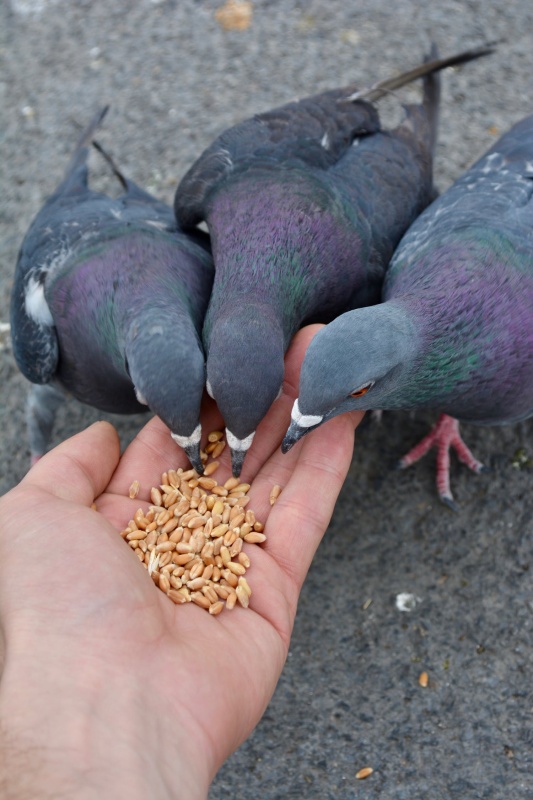
Neither federal nor regional regulations prohibit feeding birds in the city. But such restrictions can be established by municipalities in the rules for landscaping. In any case, administrative responsibility for feeding homeless and stray animals is not provided.
Part 1 2.1 of the Code of Administrative Offenses of the Russian Federation
It will also not work to recover material damage for damage to common house property or to prohibit feeding birds through the courts either.
For example, in Podolsk, the management organization filed a lawsuit against a citizen who fed street pigeons from the balcony of her own apartment. As a result, the facade of the house was constantly covered in pigeon droppings. And also, as it was stated in the lawsuit, "parasites and infection are bred" and "fleas fly into courtrooms." What kind of infection is bred, when the fleas learned to fly and how courtrooms attract them, the plaintiffs did not explain.
The managing organization argued that the defendant violated the obligation to comply with the rules for the maintenance of common property.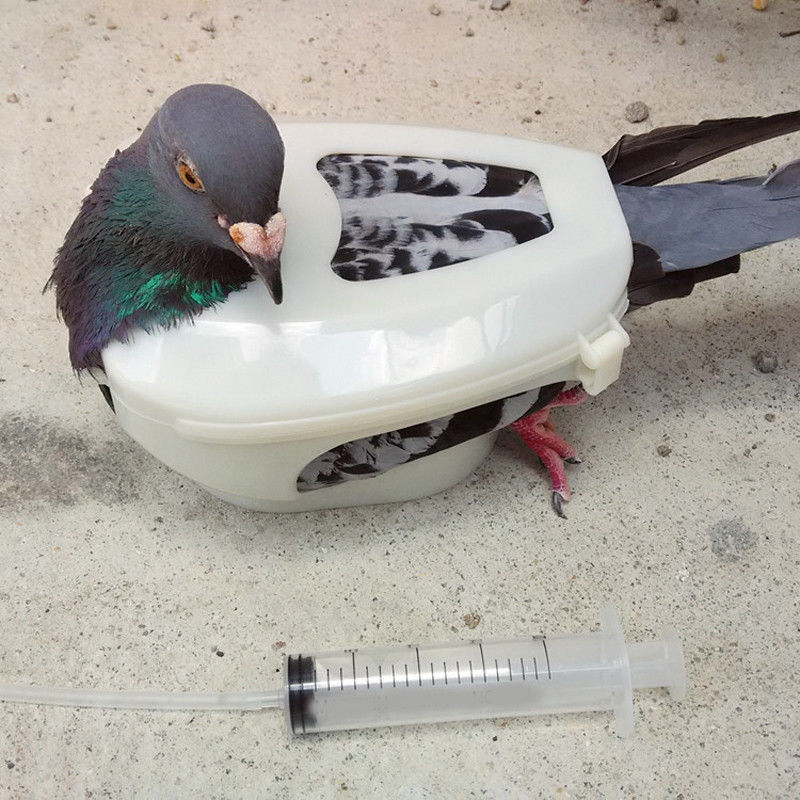 This created unfavorable living conditions for other citizens.
This created unfavorable living conditions for other citizens.
Employees of Municipal Unitary Enterprise "ZhPET No. 2" of Podolsk approached the issue seriously: they repeatedly tried to give the woman instructions on the inadmissibility of feeding street pigeons, drew up acts, and then presented them to the court as evidence of guilt.
They asked to ban the citizen from feeding the birds, but the court did not agree with them. In order to assign responsibility, it is necessary to establish guilt, the wrongfulness of behavior and a causal relationship between the behavior and the harm that has occurred. The managing organization did not provide such evidence.
As a result, the court refused to establish a ban on feeding pigeons, but warned the woman about the inadmissibility of such actions.
How can a neighbor be punished
If a person pollutes common areas, violates amenities and cleanliness with an excessive amount of bird food, this can be considered an administrative offense.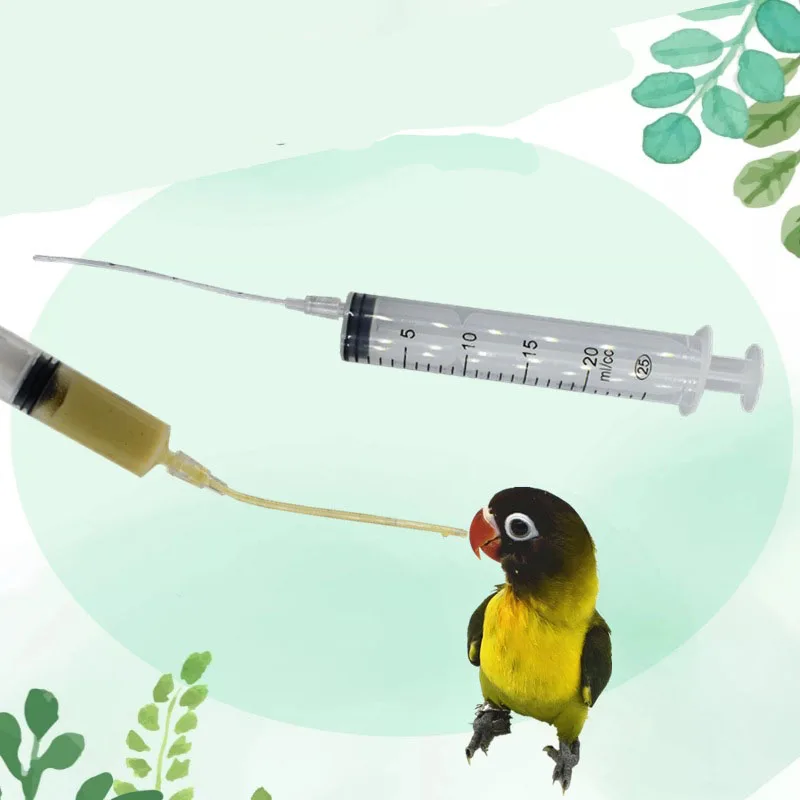
Part 2 4.9 of the Code of the Tyumen Region on Administrative Liability
Part 1 Art. 6.1 Administrative Code of the Moscow Region
For your neighbor, grain is bird food, but from the point of view of the law, it is consumer waste that she scatters around the shop. Waste management is regulated by special requirements. In short, the dumping of such waste on the soil is prohibited - they are subject to collection, accumulation and disposal.
Your yard must have facilities for waste collection. Most likely, there is a special area with garbage containers installed on it. According to the rules, the distance from them to residential buildings should be at least 20 and no more than 100 meters. Pigeons will probably be able to find grain in a container, but at such a distance they will not pollute the yard, they will not scare your cat, and the neighbor’s health will not be an obstacle to walking these 100 meters.
Community 04/16/21
How to get public utilities to take out the trash more often?
A woman may be held administratively liable for non-compliance with waste management requirements. Sanction for citizens - a fine from 2000 to 3000 R. And for repeated violation within a year - from 3000 to 5000 RUR.
Sanction for citizens - a fine from 2000 to 3000 R. And for repeated violation within a year - from 3000 to 5000 RUR.
Art. 8.2 of the Code of Administrative Offenses of the Russian Federation
Police officers can draw up a protocol on an administrative offense - just call 112 and report that you have witnessed an administrative offense and ask to bring the guilty person to justice. It is unlikely that a neighbor will wait for the police, so photo and video filming will help to establish her identity.
But to begin with, I still advise you to have another conversation with the citizen: to explain that there will be nothing for feeding the birds, but she can be fined for littering in public places. Apparently, you have an evidence base: you can use the photo that you attached. I hope you also have a photo or video recording that can make out the woman's face.
/list/make-your-city-great-again/
Where to complain about garbage in the yard and potholes on the roads: a list of services for all cities
What to do? Readers ask - experts answer
Ask your question
Feeding pigeons is dangerous for health
April 16, 2013
A meeting of the regional Extraordinary Anti-Epidemiological Commission was held in the administration of the Vyborgsky district under the chairmanship of the deputy head of the administration, Ye. N. The meeting was attended by heads of health care institutions of the district, educational institutions, epidemiologists, specialists from Rospotrebnadzor and representatives of the district administration.
N. The meeting was attended by heads of health care institutions of the district, educational institutions, epidemiologists, specialists from Rospotrebnadzor and representatives of the district administration.
Among the issues discussed at the meeting were the spread of ornithosis and deratization.
Ornithosis is an acute infectious disease that is transmitted from birds to humans. The most common ways of infection with ornithosis are contact with sick domestic, ornamental birds and city pigeons. At risk are sellers in pet stores and people who regularly feed pigeons. Ornithosis spreads by airborne dust - through the inhalation of dust containing chlamydia.
In 2012, 10 cases of ornithosis were recorded in the Vyborgsky district. Seven cases in pet store workers who had contact with diseased ornamental birds. Three cases of infection from urban pigeons.
Gathering in large flocks when feeding, pigeons not only infect each other, but also become a serious threat to the people around them.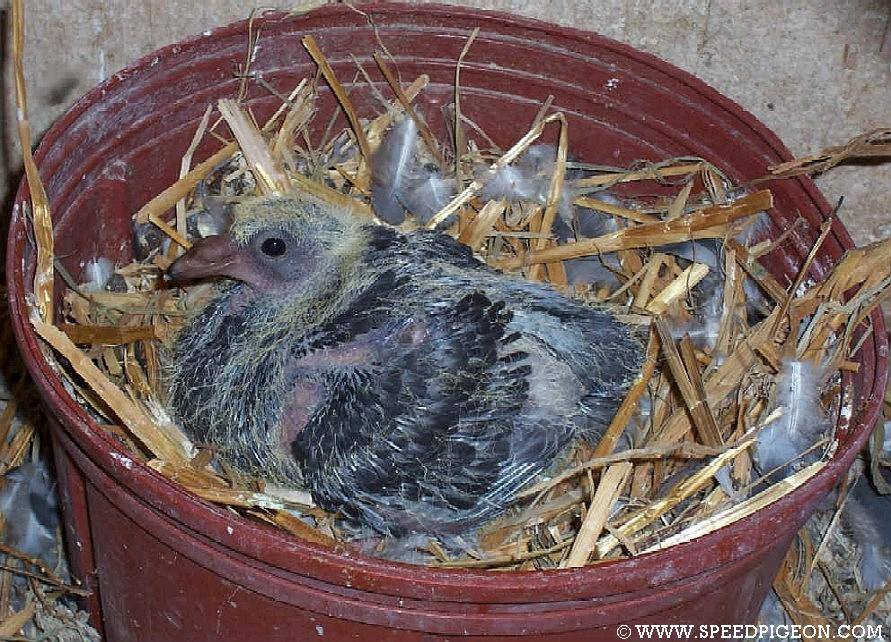
Veterinarians also warn that when buying ornamental birds in pet stores (for example, budgerigars), it is necessary to request veterinary accompanying documents for the bird. If there are no such documents, you cannot buy a bird.
All residents are strongly advised to refrain from feeding pigeons, especially in crowded places - in parks, near playgrounds, in yards. It is also extremely dangerous to feed pigeons from a window or balcony - air with dust and chlamydia will enter the apartment and may pose a threat to its residents.
Also in 2013, a one-time deratization of all institutions, residential buildings and buildings will be carried out in St. Petersburg. For more effective control of rodents, the treatment will be carried out in two stages: in the spring - from April 22 to May 21, in the autumn - from October 1 to October 31.
Ornithosis is a particularly dangerous acute infectious disease of birds and humans, characterized by fever, general weakness, symptoms of diseases of the lungs and central nervous system.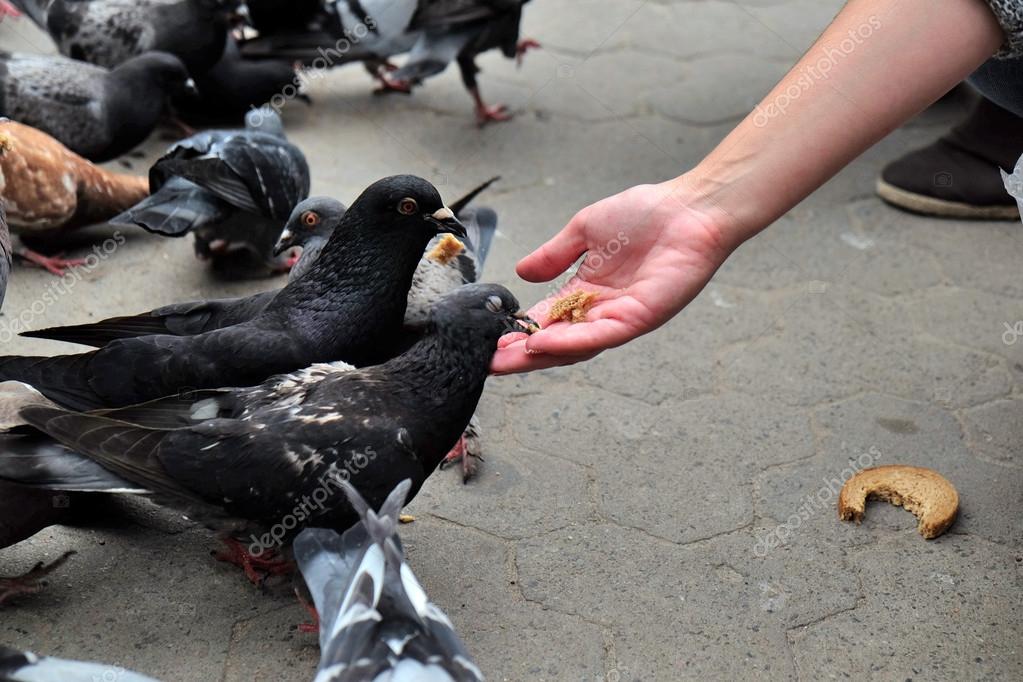 The causative agent of the disease is an intracellular microbe - chlamydia (lat. Chlamydia psittaci)
The causative agent of the disease is an intracellular microbe - chlamydia (lat. Chlamydia psittaci)
You can recognize sick birds by their behavior: they become less active, seem drowsy, their body trembles, it is difficult for the bird to breathe, it stretches its neck, opens its beak wide. Many birds have psittacosis asymptomatic , but the pathogen continues to be released into the environment when sneezing and coughing, as well as with feces. Sometimes this infection is even called "parrot disease". People who get infected from parrots get very sick.
The time from the moment of infection to the appearance of clinical signs in humans is on average 8-12 days. The first signs of the disease in humans are chills, headache and muscle pain, fever up to 38-40 degrees. There is a dry cough. From 5-7 days, chest pains, shortness of breath, cough with sputum, signs of pneumonia appear. Possible insomnia, dizziness.
It should be remembered that ornithosis is a particularly dangerous disease, which means that it is easily and quickly transmitted, only a small amount of the pathogen is required to cause the disease.


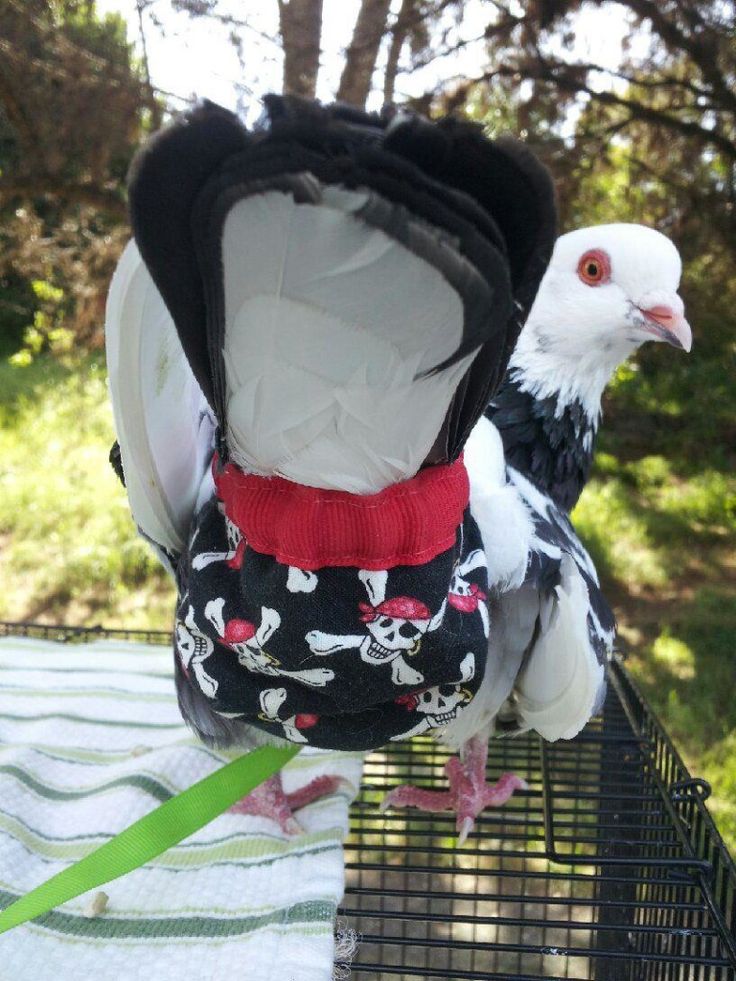 It adds
vital nutrients to the body when the pigeon may not actively take in these
nutrients on its own. Tube feeding can be useful to aid in weaning
of the young birds. This is the time when the squeakers are left on their
own to learn how to eat and drink. Every year, there always seems to be at
least one squeaker that does not "catch on" as quickly as the others. He
may even get weaker and weaker as he falls further behind. This is a good
time to tube feed. Youngsters in this situation can be fed a solution of
5% dextrose (available cheaply from your veterinarian) or, better yet, a
high calorie feeding solution containing fructose and glucose. In the pigeon,
fructose has been documented to be a highly digestible sugar being quickly
converted to usable energy.
It adds
vital nutrients to the body when the pigeon may not actively take in these
nutrients on its own. Tube feeding can be useful to aid in weaning
of the young birds. This is the time when the squeakers are left on their
own to learn how to eat and drink. Every year, there always seems to be at
least one squeaker that does not "catch on" as quickly as the others. He
may even get weaker and weaker as he falls further behind. This is a good
time to tube feed. Youngsters in this situation can be fed a solution of
5% dextrose (available cheaply from your veterinarian) or, better yet, a
high calorie feeding solution containing fructose and glucose. In the pigeon,
fructose has been documented to be a highly digestible sugar being quickly
converted to usable energy. (The sugar fructose can be found in grape juice,
honey, and in powdered preparations in health food stores. ) Fructose and
glucose can be found in many commercial feeding preparations formulated for
baby parrots. These types of solutions are excellent for those problem squeakers,
previously described. Squeakers can be tube fed twice a day for 1-3 days.
By this time, they usually have figured out how to eat and drink on their
own.
(The sugar fructose can be found in grape juice,
honey, and in powdered preparations in health food stores. ) Fructose and
glucose can be found in many commercial feeding preparations formulated for
baby parrots. These types of solutions are excellent for those problem squeakers,
previously described. Squeakers can be tube fed twice a day for 1-3 days.
By this time, they usually have figured out how to eat and drink on their
own. They come as a powder,
to be mixed with water. They are usually used on parrots, but are fantastic
for sick pigeons. I use them regularly for individual bird treatments. Another
good mixture is made by grinding pigeon pellets and water together in a blender.
This is also a well-balanced diet for the sick, non-eating bird, and can
be fed twice daily very easily. Oral antibiotics can also be mixed right
into the formula and placed directly into the crop.
They come as a powder,
to be mixed with water. They are usually used on parrots, but are fantastic
for sick pigeons. I use them regularly for individual bird treatments. Another
good mixture is made by grinding pigeon pellets and water together in a blender.
This is also a well-balanced diet for the sick, non-eating bird, and can
be fed twice daily very easily. Oral antibiotics can also be mixed right
into the formula and placed directly into the crop.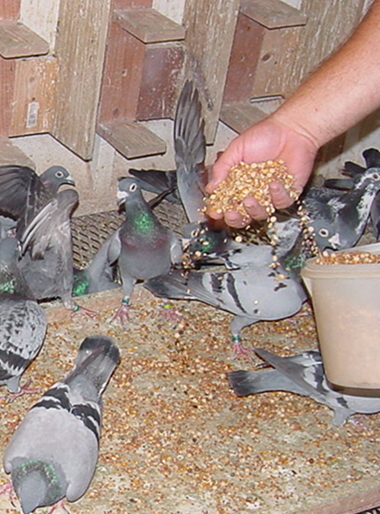 A "regular"
syringe can be used if you are only going to feed water or water/electrolyte
solutions. Glass syringes are nice, but they can break easily when dropped.
Plastic syringes are best, as they are very durable and easily cleaned. There
are two types of feeding tubes available: rigid stainless steel tubes; or
flexible, rubber feeding tubes. I prefer the flexible, round tipped feeding
tubes, as they are soft and flex as they are passed into the crop.
A "regular"
syringe can be used if you are only going to feed water or water/electrolyte
solutions. Glass syringes are nice, but they can break easily when dropped.
Plastic syringes are best, as they are very durable and easily cleaned. There
are two types of feeding tubes available: rigid stainless steel tubes; or
flexible, rubber feeding tubes. I prefer the flexible, round tipped feeding
tubes, as they are soft and flex as they are passed into the crop.  Soft rubber tubes are much safer. The tube size I use has an outside diameter
of no more than 0.4 cm (4 mm). Once learned, this procedure is very easy
and can be done alone. When first learning, have an assistant hold the pigeon
so both your hands are free. When holding the pigeon, care must be taken
NOT to put any pressure over the crop area. (Pressure on the crop can cause
regurgitation [vomiting] of the feeding solution.) Next, the pigeon's neck
is straightened out vertically while the beak is opened. With the mouth opened,
it is easy to see the opening into the trachea or windpipe. It is on the
lower portion of the mouth just behind the tongue. It will contract open
with every breath. The tube is then gently placed past this opening to the
rear of the mouth on the bird s right side.
Soft rubber tubes are much safer. The tube size I use has an outside diameter
of no more than 0.4 cm (4 mm). Once learned, this procedure is very easy
and can be done alone. When first learning, have an assistant hold the pigeon
so both your hands are free. When holding the pigeon, care must be taken
NOT to put any pressure over the crop area. (Pressure on the crop can cause
regurgitation [vomiting] of the feeding solution.) Next, the pigeon's neck
is straightened out vertically while the beak is opened. With the mouth opened,
it is easy to see the opening into the trachea or windpipe. It is on the
lower portion of the mouth just behind the tongue. It will contract open
with every breath. The tube is then gently placed past this opening to the
rear of the mouth on the bird s right side. If done correctly, the tube will
pass very easily down the throat into the crop. Do not force it if you feel
resistance.
If done correctly, the tube will
pass very easily down the throat into the crop. Do not force it if you feel
resistance.